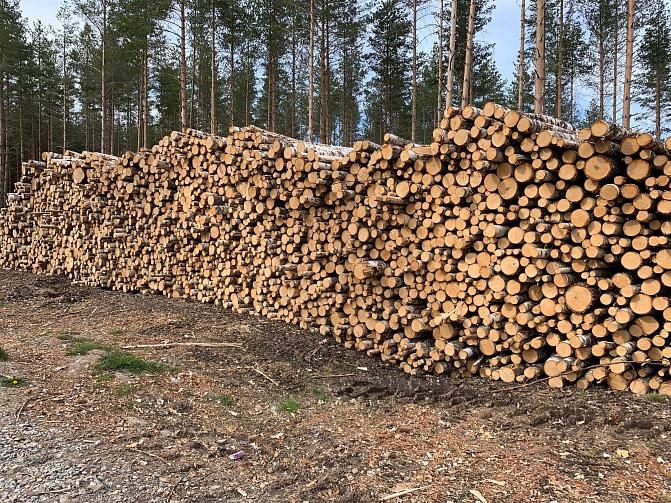Removals increased to 76 million cubic metres in 2021

Total roundwood removals increased by 11 per cent from the previous year, exceeding the average felling of the past five years by five per cent. In 2021, the felling volume of logs was 29, pulpwood 37 and energywood 10 million cubic metres.
A total of 65.7 million cubic metres of logs and pulpwood was felled for industrial use and exports. The volume was 7.5 million cubic metres higher than in the previous year and four per cent higher than the previous five years’ average.
“Industrial roundwood removals in 2021 were the second highest in the history of the statistics, falling three million cubic metres short of the 2018 level,” says Tiina Sauvula-Seppälä, senior statistician at the Natural Resources Institute Finland (Luke).
Felling of logs in non-industrial private forests increasing
Log removals were 29.0 and pulpwood removals 36.7 million cubic metres, with log removals increasing by 17 per cent and pulpwood removals by ten per cent from the previous year. Logs were also played a significant role in a long-term comparison: log removals were nine per cent higher than the previous five years’ average, while pulpwood removals remained at the same level.
Of different assortments, the felling volumes of spruce and birch logs increased relatively the most, by 19 per cent. Pine logs also increased by 15 per cent. The change was especially prevalent in non-industrial private forests, in which log removals increased by a fifth. In state- and company-owned forests, log removals decreased, however. Logs accounted for 57 per cent of industrial roundwood removals in Päijät-Häme region, while the corresponding figure was only 30 per cent in Northern Finland.
Removals increased by nearly a quarter in Northern Ostrobothnia
Four regions accounted for 40 per cent of domestic industrial roundwood: North Savo, North Ostrobothnia, North Karelia, and Central Finland. In each region, the felling volume was more than six million cubic metres.
Removals increased in nearly all regions The felling volume was the largest in North Savo, in which industrial roundwood removals totalled nearly seven million cubic metres. In North Ostrobothnia, industrial roundwood removals increased by more than a quarter to 6.8 million cubic metres.
Energywood removals showing a small increase
In commercial felling, 6.5 million cubic metres of energywood was harvested for heat and power plants. Stemwood, i.e. whole-trees and delimbed stems, accounted for 3.8 million cubic metres of this volume.
Energywood removals increased by five per cent from the previous year. This increase mainly came from logging residues, whose removals increased by a fifth. Changes in roundwood removals are also reflected in the amount of available logging residues. Currently, stumps only account for a small part of energywood removals.
Removals totalled 76 million cubic metres
In addition to commercial felling, wood was harvested for private use by forest owners and as fuelwood for small-scale housing.
“Total roundwood removals increased to 76.3 million cubic metres. Removals exceeded the previous five years’ average by five per cent and fell just under two million cubic metres short of the 2018 figures,” says Jukka Torvelainen, senior statistician at Luke.
A total of 66.1 million cubic metres of logs and pulpwood was harvested for industrial use and for the private needs of forest owners. This was 13 per cent higher than in the year before. The total volume of stemwood harvested for energywood, i.e. forest chips for heat and power plants and fuelwood for small-scale housing, remained at 10.3 million cubic metres.
96 per cent of felling potential in use in Southern Finland
Luke has estimated the sustainable yield of commercial timber and energywood harvested from our forests during the period from 2016 to 2045. The felling potential estimate during the entire period increases every ten years and is 86.3 million cubic metres a year on average. For the first period between 2016 and 2025, the estimate is an average of 80.5 million cubic metres of stemwood per year.
“Felling volumes and felling potential estimates should be compared over periods of several years, because felling volumes vary from one year to the next. In the period from 2016 to 2021, the whole country’s felling volumes were on average 91 per cent of the felling potential. In Northern Finland in the three northernmost regions, 76 per cent of the felling potential were used. However, felling volumes in Southern and Central Finland were significantly higher, covering 96 per cent of the estimated felling potential,” Torvelainen says.
Average removals between 2016 and 2021 exceeded the sustainable yield in six regions. The level was exceeded by 14 per cent in South Karelia and by six per cent in Päijät-Häme. In the regions of Kanta-Häme, Pirkanmaa, Kymenlaakso and South Savo, the excess was between one and four per cent.
“When examining the 2021 situation alone, felling volumes covered 99 per cent of the felling potential in the regions of Southern and Central Finland. In addition to the aforementioned six regions, last year’s felling volumes were also higher than the estimated felling potential in Satakunta, North Savo and the Åland Islands,” Torvelainen says.
The annual increment 103 million cubic metres, drain 92 million
Some 10 million cubic metres of stemwood remained in forests in 2021 in the form of logging residues. In addition, six million cubic metres of naturally died stemwood remained in forests. Combined with removals, they reduce the growing tree stocks in forests.
“In 2021, a total of 76 million cubic metres of felled stemwood was consumed, while 15 million cubic metres of naturally died stemwood remained in forests. As a result, total drain increased to 92 million cubic metres. According to the most recent estimates, some 103 million cubic metres of new stemwood grow in our forests every year. This means that the total stemwood volume increased by roughly 12 million cubic metres in the whole of Finland,” Torvelainen says.
Additional information:
Commercial fellings: Tiina Sauvula-Seppälä
Total roundwood removals and drain: Jukka Torvelainen
Statistical publication
See statistics data related to the news in the statistical publication.




